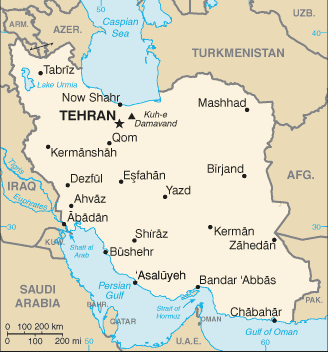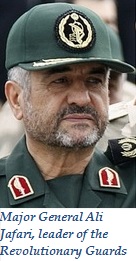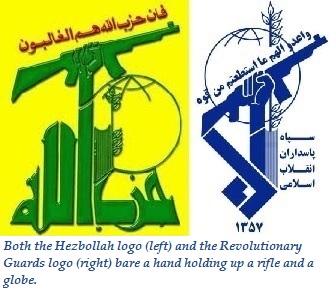Cameron Glenn and Garrett Nada
Despite their similar names, the Islamic Republic of Iran and the Islamic State of Iraq and Syria represent two distinct visions of an ideal state based on the faith. They have more differences than similarities in politics, economic life, culture and, most of all, how they blend politics and religion.
The disparity between ISIS and Iran largely derives from their particular interpretations of Islam. ISIS, like al Qaeda and other jihadi groups, espouses a militant Salafi ideology. Despite its use of modern weaponry and social media, its members largely look to the seventh century for inspiration.
Post-revolution Iran, on the other hand, is the product of innovation by late revolutionary leader Ayatollah Ruhollah Khomeini, who crafted a political system not entirely theocratic nor entirely republican. As a result, approaches to governance in the two places starkly contrast with each other.
The Islamic State and Iran have at least one thing in common, however. Both fall short of the idyllic visions they profess. Both have engaged in political inequities, human rights violations, economic corruption and social discrimination. Iran ranks poorly on these issues compared to most other countries, but its people generally enjoy much more freedom than those living under ISIS control.
The Islamic State
The ISIS experiment in blending Islam and politics remains in its infancy. The movement emerged from the remnants of al Qaeda in Iraq, founded in 2004. It rebranded itself as the Islamic State in Iraq in 2006. The “surge” of U.S. troops in 2007 drove the group from its strongholds, killing and imprisoning many of its core members. But it made a comeback when Syria’s civil war broke out in 2011. The group changed its name to the Islamic State of Iraq and Syria (ISIS) in 2013.
ISIS began capturing Iraqi territory in 2013. By January 2014, the group had established a de facto capital in Raqqa, Syria. In June 2014, ISIS launched an offensive that seized large swaths of territory across northern Syria and Iraq. ISIS leader Abu Bakr al Baghdadi declared a caliphate stretching from Aleppo in Syria to Diyala in Iraq, rebranding the group the Islamic State.
ISIS has yet to present a detailed plan for governing the towns and cities under its control. But it has established a basic bureaucracy in its territories, with institutions based on its interpretation of Islam.
Iran
Iran’s experiment with political Islam dates back to the 1979 revolution led by Ayatollah Ruhollah Khomeini. It brought together a full range of political factions, including leftists, nationalists and Islamists. Iran’s revolutionary constitution reflects the mix. Governance must be compliant with Sharia, or Islamic law, and it vests ultimately authority in the hands of the clerics. But day-to-day rule is based on republican institutions that include separate branches of executive, legislative and judicial branches. Both the presidency and parliament are popularly elected. The push and pull between Islam and democracy has been and continues to be central to Iranian politics.

Iran has not fought an overt offensive war in centuries. Its eight-year war with Iraq was a result of President Saddam Hussein’s invasion. “We have never expanded for the last 300 years, almost three centuries. Iran has not waged a war against anybody,” Foreign Minister Mohammad Javad Zarif emphasized in a 2014 interview with NPR.
The following is a rundown of key parallels and differences based on ISIS publications and Iran’s constitution.
Government
ISIS and Iran both describe the state as an entity embodying a pure, idealized form of Islam. The state is not supposed to serve the interests of any particular individual or group. But ISIS fighters in Iraq and Syria and the clerical establishment in Iran have benefited disproportionately compared to other sectors of society.
“By Allah’s grace – you have a state and Khilafah, which will return your dignity, might, rights, and leadership. It is a state where the Arab and non-Arab, the white man and black man, the easterner and westerner are all brothers. It is a Khilafah that gathered the Caucasian, Indian, Chinese, Shami, Iraqi, Yemeni, Egyptian, Maghribi (North African), American, French, German, and Australian. Allah brought their hearts together, and thus, they became brothers by His grace, loving each other for the sake of Allah, standing in a single trench, defending and guarding each other, and sacrificing themselves for one another. Their blood mixed and became one, under a single flag and goal, in one pavilion, enjoying this blessing, the blessing of faithful brotherhood.” - Speech by ISIS leader Abu Bakr al Baghdadi In practice: Baghdadi describes a utopian Islamic society encompassing Muslims of all ethnicities. The influx of foreign fighters to the Islamic State seems to reflect this global orientation, as more than 20,000 militants from 80 countries have reportedly flocked to Syria. But reports suggest that life in the Islamic State is not as idyllic as its leaders claim. Foreign fighters occupy many of the top administrative posts in the bureaucracy, generating resentment among Syrians. ISIS fighters also reportedly benefit disproportionately from the collection of taxes, receiving generous salaries and benefits from tax revenues without being required to contribute to them. | “In the view of Islam, government does not derive from the interests of a class, nor does it serve the domination of an individual or a group. It represents rather the crystallization of the political ideal of a people who bear a common faith and common outlook, taking an organized form in order to initiate the process of intellectual and ideological evolution towards the final goal, i.e., movement towards Allah. Our nation, in the course of its revolutionary developments, has cleansed itself of the dust and impurities that accumulated during the taghuti [idol-worshipping] past and purged itself of foreign ideological influences, returning to authentic intellectual standpoints and world-view of Islam. It now intends to establish an ideal and model society on the basis of Islamic norms.” In practice: Iran’s constitution lays out an idyllic vision that does not serve the interests of any particular group. But in reality, a few groups have disproportionately benefited from the system. The clerical establishment has grown rich and powerful since 1979. Supreme Leader Ayatollah Ali Khamenei, for example, reportedly controls a multi-billion financial empire.  The Revolutionary Guards have steadily gained control over large sectors of the economy since the 1990s, including energy, telecommunications, construction, banking and finance. The policies of the Ahmadinejad administration (2005-2013) led to privatization of the largely state-run economy that particularly benefitted companies associated with the Revolutionary Guards. The Guards, likely the most powerful economic actor in Iran, also control many charitable foundations (bonyads) that are tax-exempt and largely unregulated by the government. The Revolutionary Guards have steadily gained control over large sectors of the economy since the 1990s, including energy, telecommunications, construction, banking and finance. The policies of the Ahmadinejad administration (2005-2013) led to privatization of the largely state-run economy that particularly benefitted companies associated with the Revolutionary Guards. The Guards, likely the most powerful economic actor in Iran, also control many charitable foundations (bonyads) that are tax-exempt and largely unregulated by the government. |
Laws and Courts
The nascent ISIS court system and Iran’s penal code are both based on sharia. ISIS carries out the most severe forms of punishment under Islamic law, known as hudud. Lashings, stonings, amputations, and executions, as well as mass killings of religious minorities are common. Iran may be less brutal and indiscriminate in doling out punishments, but its penal code also includes the hudud. Iran also has a more sophisticated court system.
“[Courts] govern by the laws of God, implement the hudud punishments, ensure rights, and extend justice; dozens of cases are dealt with daily, and it is based upon a legal and administrative cadre” - ISIS report on the Aleppo province (translation via Institute for the Study of War) “We treat people by what is shown to us by their actions and their devotion to Islam. Our actions are based on unequivocal evidence and not based on supposition and questionable premises.” - From an ISIS city charter “Individuals under our rule are safe and are supported under Islamic law, where their individual rights are preserved and justice is served to protect the oppressed.” - From an ISIS city charter In practice: ISIS began establishing courts in July 2013, and has since expanded its judicial system. The group’s bureaucracy also includes local police forces and religious police. ISIS has conducted lashings, stonings, amputations, and executions for a wide range of violations, including adultery, theft, and apostasy. While the total number of ISIS executions has not been verified, A U.N. report estimates that ISIS militants killed 8,493 civilians in Iraq alone in 2014. The group claimed to have executed 1,700 Shiites in a single incident, after seizing a prison outside Mosul in June. The group’s bureaucracy also includes local police forces and religious police, known as al Hisba, who conduct regular patrols to crack down on religious offenses like insulting God or conducting business transactions during prayer time. As of July 2014, there were more than a dozen Hisba offices in Raqqa and Aleppo that had logged hundreds of violations. | “The judiciary is of vital importance in safeguarding the rights of the people in accordance with the line followed by the Islamic movement, and the prevention of deviations within the Islamic nation. Provision has therefore been made for the creation of a judicial system based on Islamic justice and operated by just judges with meticulous knowledge of the Islamic laws. Article 32 “No one may be arrested except by the order and in accordance with the procedure laid down by law… Article 34 “It is the indisputable right of every citizen to seek justice by recourse to competent courts. All citizens have right of access to such courts, and no one can be barred from courts to which he has a legal right of recourse. Article 35 “Both parties to a lawsuit have the right in all courts of law to select an attorney, and if they are unable to do so, arrangements must be made to provide them with legal counsel.” In practice: Iran’s legal system includes many layers of civil, criminal and military courts. But it also has two sets of tribunals outside of the judiciary, the Revolutionary Courts and the Special Court for the Clergy. The latter has been used as a political tool to silence clerics who urge reform or challenge the regime. Amputation, flogging and stoning to death are all legal according to Iran’s penal code. The code’s latest iteration, which entered into force in 2013, “now omits references to apostasy, witchcraft and heresy, but continues to allow for juvenile executions,” according to a U.N. report. The death penalty applies to a wide range of crimes, including drug-related offenses, adultery, rape, sodomy, insulting the Prophet Mohammad and crimes against national security. Iran has seen a sharp rise in executions during the past few years. At least 411 were executed between January and June 2014, according to a recent U.N. report. In addition to a regular police force, Iran also has a volunteer paramilitary organization operating under the Revolutionary Guards. The Basij Resistance Force is responsible for supplementing internal security forces, law enforcement and morals policing. The ubiquitous group has a claimed membership of 12.6 million, but perhaps only 1 million are combat capable. And the number of full-time, uniformed and active members may be less than 100,000. The Basij played an important role the anti-government protests following the disputed 2009 presidential elections. |
Global Aspirations
Image -- The Islamic State's link in N. #Sinai, Jamaat Ansar Bayt Al-Maqdis. #Egypt pic.twitter.com/Bbi545f7YD
— Flashpoint Partners (@FlashpointIntel) January 30, 2015Both ISIS and Iran seek to export their forms of Islamic governance. ISIS has attempted to globalize its influence by calling on Muslims around the world to migrate to the Islamic State or pledge allegiance to it. Militants from more than ten countries, including Libya, Egypt and Algeria, have publicly sworn allegiance to it.
After the devastating war with Iraq from 1980-1988, Tehran gradually scaled back its efforts to export its brand of Islamic revolution. It has aided groups with common causes, like Palestinian Islamic groups Hamas and Islamic Jihad and Hezbollah in Lebanon. Iran has also cultivated spheres of influence in Shiite communities elsewhere, such as Afghanistan. But the goal has not been to gain territory for the Islamic Republic.
“The Islamic State is facing a growing list of enemies, and it further underscores the fact that the lines are being drawn and the camps of īmān (believers) and kufr (non-believers) are both being cleansed. This will eventually lead to a camp of kufr with no trace of īmān, and a camp of īmān with no trace of hypocrisy, as per the statement of the Prophet...all parties will soon be forced to make a choice between the two.” - Issue # 4 of ISIS's "Dabiq" magazine “With this declaration of the caliphate, it is incumbent upon all Muslims to pledge allegiance to the Caliph Ibrahim and support him…The legality of all emirates, groups, states, and organizations becomes null by the expansion of the caliph’s authority and arrival of its troops to their areas.” - Spokesman Shaykh Abu Muhammad al-Adnani al-Shami, "This is the Promise of Allah" “If you cannot perform hijrah for whatever extraordinary reason, then try in your location to organize bay’āt (pledges of allegiance) to the Khalīfah Ibrāhīm. Publicize them as much as possible.” - Issue # 2 of ISIS's "Dabiq" magazine In practice: ISIS militants captured large swaths of territory in Syria and Iraq in 2014. The group has not yet conquered land elsewhere, but has attempted to promote the Islamic State globally. ISIS publications encourage Muslims around the world to either migrate to the Islamic State or declare allegiance to it. Jihadists in nearly a dozen countries – including Libya, Algeria, Egypt, and Saudi Arabia – have reportedly pledged allegiance to ISIS. It is unclear, however, how much direct control ISIS has over its affiliated branches. | “With due attention to the Islamic content of the Iranian Revolution, which has been a movement aimed at the triumph of all the mustad'affun [oppressed] over the mustakbirun [oppressors], the Constitution provides the necessary basis for ensuring the continuation of the Revolution at home and abroad. In particular, in the development of international relations, the Constitution will strive with other Islamic and popular movements to prepare the way for the formation of a single world community (in accordance with the Qur'anic verse ‘This your community is a single community, and I am your Lord, so worship Me " [21:92] ) and to assure the continuation of the struggle for the liberation of all deprived and oppressed peoples in the world.’” In practice: Iran has both a conventional military and the Islamic Revolutionary Guards Corps. The constitution commits both to extending God’s sovereignty throughout the world. But in practice, Iran has only fought defensively in conventional wars and within its borders since the 1979 revolution. Iran has not used its armed forces to take additional territory. The theocracy has actually had little success in exporting its Islamic revolution. Tehran funds the activities of clerics trained in the holy city of Qom and promotes its brand of Islam in Shiite communities across the world. But the strength of Iran’s soft power is debatable. In the 1990s, Iran largely abandoned attempts to spread its revolution among the Shiite minority in the Gulf. The few elites who do subscribe to the concept of clerical rule and consider Supreme Leader Khamenei their marja’ (cleric for emulation) do not enjoy wide support. Iran has had much more success setting up and assisting armed organizations beyond its borders that share its goals and values. In Lebanon, the Islamic Republic has used Hezbollah to expand its influence in Lebanon and challenge Israel. The powerful Shiite militia and political party has its own domestic agenda and interests. But the Revolutionary Guards initially set up the organization in the 1980s, and Hezbollah has continued to play an important role in Iran’s regional policy.  In Gaza and the West Bank, Iran has aided Islamic groups committed to armed struggle against Israel. Iran has provided arms, training and funds to Islamic Jihad and Hamas. |
*Click here for a full translation of Iran’s constitution.
Online news media are welcome to republish original blog postings from this website in full, with a citation and link back to The Iran Primer website (www.iranprimer.com) as the original source. Any edits must be authorized by the author. Permission to reprint excerpts from The Iran Primer book should be directed to permissions@usip.org
Photo credits: Iran flag by SiBr4 via Wikimedia Commons [Public Domain]; Islamic State flag by Global Panorama [CC 2.0 https://creativecommons.org/licenses/by-sa/2.0/], via Flickr commons
